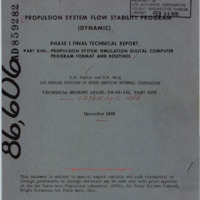-
Title
-
Propulsion System Flow Stability Program (Dynamic). Part XVII. Propulsion System Simulation Digital Computer Program Format and Routines
-
Date
-
1968
-
Index Abstract
-
Coming Soon
-
Photo Quality
-
Not Needed
-
Report Number
-
AFAPL TR 68-142 Part XVII
-
Creator
-
Kaplan, Earl H.
-
Wong, Heeman W.
-
Corporate Author
-
North American Rockwell Corp Los Angeles CA Los Angeles Div
-
Extent
-
137
-
NTRL Accession Number
-
AD859282
-
Identifier
-
AD0859282
-
AD0859282
-
Distribution Classification
-
1
-
DTIC Record Exists
-
Yes
-
Distribution Change Authority Correspondence
-
AFAPL LTR
-
Date Modified
-
Scanned by request 1/14/2019 submitted by a Private Citizen (Private Citizen - No Known Affiliation)
-
Report Availability
-
Full text available
-
Date Issued
-
1968-12
-
Abstract
-
The primary objective of Task 7 of the "Propulsion System Flow Stability Program" was to develop a simulation program to be used in Phase II for the evaluation of two control systems capable of sensing and accommodating a transient condition. Since the work on this task was being performed by three companies, every effort was made to insure compatibility in terminology, units, and program documentation as well as to provide means of communicating the myriad details involved in making computer runs of the system. This documentation format is described in Section II of this volume. An early element of this task was the selection of a simulation language for use in programming the simulation. The choice of IBM's DSL/90 and the factors involved in making that choice are discussed in Section III. Simulation programs have a natural tendency to be rather voluminous and, when the system being simulated is as complex as a supersonic inlet, turbofan, and an integrated control system can be, computer storage space is rapidly filled. To alleviate this crowding, numerous logic blocks which were repetitive, such as compressor logic, were removed from the simulation logic deck and made into subroutines or functions. These subprograms are discussed in Section IV. Once the simulation logic is written, the most difficult task of all begins. The job of initialization is usually not given proper emphasis until many hours of work have convinced all concerned that it is really the most important phase. Section V discusses this task and shows an example of an initialization routine.
-
Publisher
-
Wright-Patterson Air Force Base, OH : Air Force Aero Propulsion Laboratory, Air Force Systems Command
-
Laboratory
-
Air Force Aero Propulsion Laboratory
-
Contract
-
F33615-67-C-1848
-
Distribution Conflict
-
No
-
Access Rights
-
Export Controls
-
Provenance
-
Lockheed Martin Missiles & Fire Control
-
Type
-
report
-
Format
-
1 online resource
 AFAPLTR68-142part17.pdf
AFAPLTR68-142part17.pdf